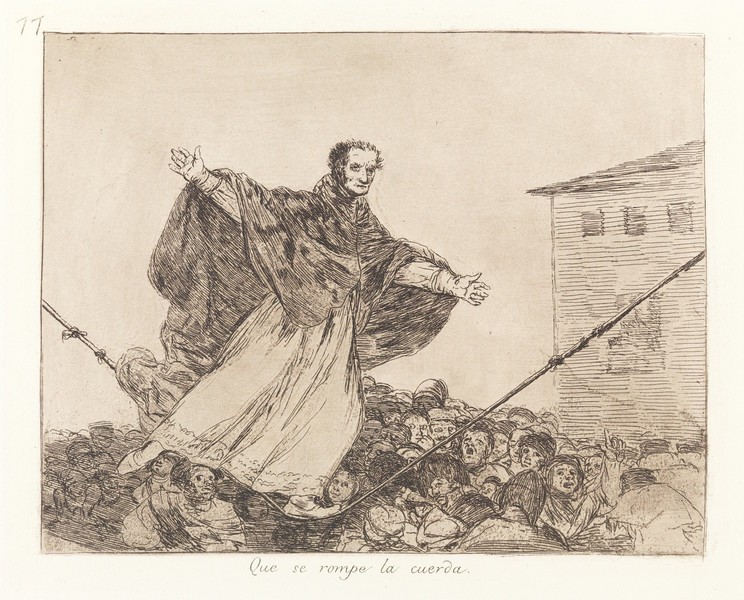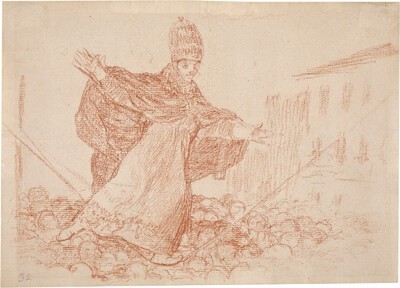- Cronología
- Ca. 1820 - 1823
- Dimensiones
- 178 x 221 mm
- Técnica y soporte
- Aguafuerte, aguatinta bruñida o lavis, punta seca y bruñidor
- Reconocimiento de la autoría de Goya
- Undisputed work
- Ficha: realización/revisión
- 28 Feb 2013 / 05 Jun 2023
- Inventario
- 225
77 (in the upper left-hand corner of the plate)
See Sad forebodings of what is to come.
The title of the print was handwritten by Goya on the first and only series known to us at the time of its production, which the painter gave to his friend Agustín Ceán Bermúdez. Thus the title was subsequently engraved on the plate without any modification from Ceán Bermúdez's copy for the first edition of the Disasters of War published by the Royal Academy of Fine Arts of San Fernando in Madrid in 1863.
A preparatory drawing of this engraving is in the Prado Museum
An ecclesiastical figure dressed in pompous robes walks with his arms outstretched on a knotted rope. The people watching him show disbelief and suspense on their faces, or simply look on with a certain indifference, waiting for the rope to break.
The study of his preparatory drawing, in which the figure wears a papal tiara on his head, is decisive for the interpretation of this engraving. We therefore conclude that it is quite likely that the figure walking on the tightrope was Pius VII (Cesena, 1742-Rome, 1823) and that Goya subsequently thought that it might be advisable not to make the identification of the figure in the print so obvious with a view to a possible publication of the series of engravings.
Pius VII was well described in his texts by Juan Antonio Llorente (Rincón de Soto, La Rioja, 1756-Madrid, 1823); secretary of the Inquisition during the nineties of the 18th century and ambassador of the second constitutional government to the Vatican between 1820 and 1823. His stay in Rome helped him to write a history of the papacy in which he gave some interesting insights into the opportunistic personality of the supreme pontiff: "Pius VII will be ungrateful if he denies that he owes Napoleon Bonaparte the freedom and power of his electors and the peaceful possession of his chair in Rome". Further on he wrote: "The French wanted to elevate their first consul to the dignity of emperor and Pius VII went from Rome to Paris with great pleasure to crown him, as he did in a great ceremony with incomparable solemnity. Subsequently, political affairs took a different turn, and the Emperor stripped Pius VII of the temporal sovereignty of the Roman states". After the fall of Napoleon, Pius VII removed from office all the bishops who had been placed there by virtue of an agreement between him and Napoleon.
Ferdinand VII asked the Pope to promulgate a bull in which he pardoned the religious who had joined the guerrillas during the War of Independence. In addition, the Spanish monarch asked the Church, with the approval of Pius VII, for priests to demand that the people pay taxes from their pulpits. This commitment on the part of the Church placed it in a position that could be what Goya has captured in this engraving, that of someone walking a tightrope full of knots and patches that presage the fall before the attentive gaze of the people.
Nigel Glendinning makes some interesting observations about this engraving, as he considers the image to be a representation of the saying "to walk on a tightrope", which means to be involved in some dangerous action. In this way Goya refers to the somewhat ambiguous dealings in which the Church found itself at that time with the Spanish monarchy in order to obtain its protection, although accepting conditions of a certain risk.
The Rope Breaks continues the compositional scheme employed by Goya in the previous engravings, No. 75, A Charlatan's Parade and No. 76, The Carnivorous Vulture, in which the centrepiece of the image is a large central figure with its limbs spread out.
The plate is in the National Chalcography (cat. 328).
-
Goya and his timesThe Royal Academy of ArtsLondon1963cat. 66cat. 253
-
Goya. Das Zeitalter der Revolucionen. Kunst um 1800 (1980 – 1981)Hamburger KunsthalleHamburg1980cat. 63
-
Goya y el espíritu de la IlustraciónMuseo Nacional del PradoMadrid1988from October 6th to December 18th 1988. Exhibited also at Museum of Fine Arts, Boston, January 18th to March 26th 1989; The Metropolitan Museum of Art, Nueva York, May 9th to July 16th 1989, Madrid curator Manuela B. Mena Marqués, scientific directors Alfonso E. Pérez Sánchez and Eleanor A. Sayrecat. 159
-
Francisco de GoyaMuseo d'Arte ModernaLugano1996exhibition celebrated from September 22nd to November 17th.cat. 77
-
Francisco Goya. Sein leben im spiegel der graphik. Fuendetodos 1746-1828 Bordeaux. 1746-1996Galerie KornfeldBern1996from November 21st 1996 to January 1997cat. 167
-
Ydioma universal: Goya en la Biblioteca NacionalBiblioteca NacionalMadrid1996from September 19th to December 15th 1996cat. 232
-
Francisco Goya. Capricci, follie e disastri della guerraSan Donato Milanese2000Opere grafiche della Fondazione Antonio Mazzottacat. 157
-
Goya: Prophet der ModerneAlte NationalgalerieBerlin2005from July 13th to October 3th 2005. Exhibitied also at the Kunsthistorischemuseum, Vienna, October 18th 2005 to January 8th 2006, consultant editor Manuela B. Mena Marquéscat. 125
-
Goya et la modernitéPinacothèque de ParisParís2013from October 11st 2013 to March 16th 2014cat. 116
-
Goya: Order and disorderMuseum of Fine ArtsBoston2014cat. 143
-
Goya, grabadorMadridBlass S.A.1918cat. 179
-
Goya engravings and lithographs, vol. I y II.OxfordBruno Cassirer1964cat. 197
-
Vie et ouvre de Francisco de GoyaParísOffice du livre1970cat. 1128
-
A solution to the enigma of Goya’s emphatic caprices nº 65-80 of The Disasters of WarApollo1978pp.186-191
-
Goya y el espíritu de la IlustraciónMadridMuseo del Prado1988pp.443-445, cat. 159
-
Catálogo de las estampas de Goya en la Biblioteca NacionalMadridMinisterio de Educación y Cultura, Biblioteca Nacional1996cat. 301
-
Goya en tiempos de guerraMadridMuseo Nacional del Prado2008p.344, fig. 117.1
-
ParísPinacoteca de París2013p. 158
-
Goya: Order & DisorderBostonMuseum of Fine Arts Boston Publications2014p. 225
-
Goya. In the Norton Simon MuseumPasadenaNorton Simon Museum2016pp. 114-151

